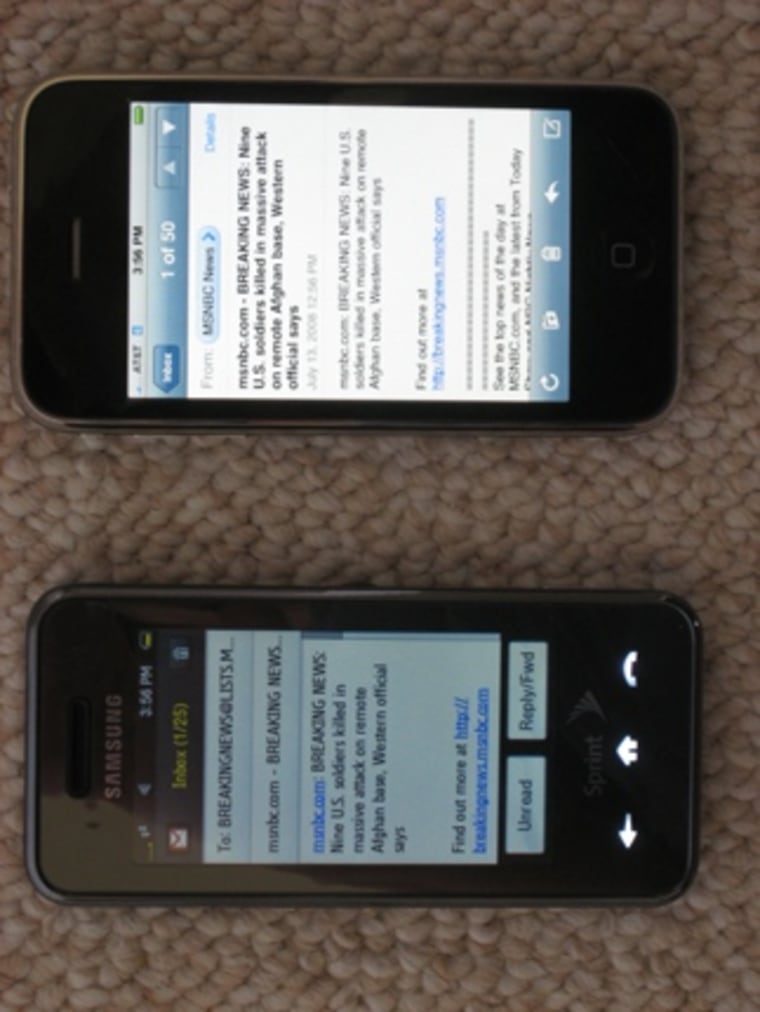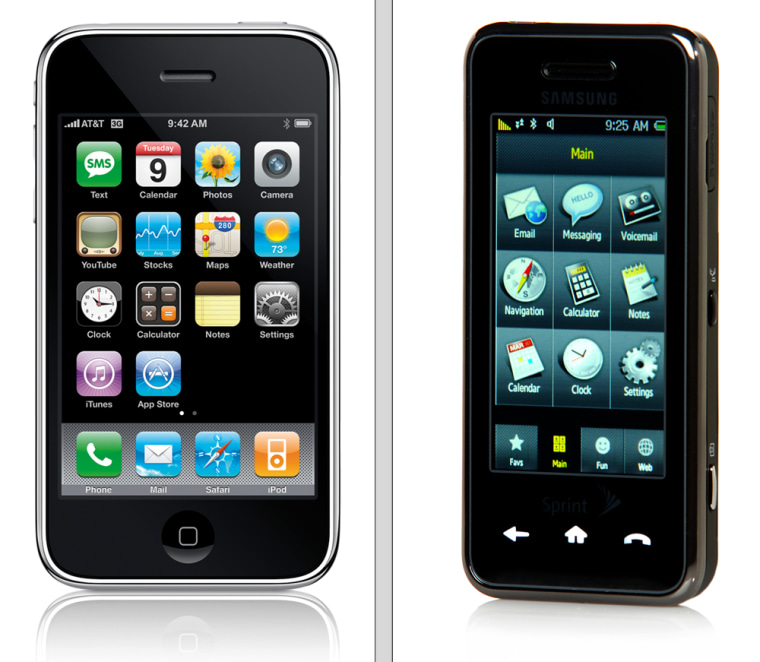Is Samsung’s Instinct, a phone carried by Sprint, the “iPhone killer” it has been billed to be by both companies?
No. Both touchscreen-only phones are excellent devices. Both phones run on faster wireless networks, called 3G, for third-generation wireless. That means data, such as e-mail and Web surfing, moves more quickly than on many current phones which are 2 or 2.5G. Both phones have their plusses and minuses.
In the end, neither may be right for you. But between the two, the new iPhone, released Friday, is superb largely because it’s relatively simple to use and because of the vivid visual experience and multi-touch screen it offers. That makes it a pleasure to maneuver around the screen, especially for Web-browsing and e-mail. The iPhone really is like carrying a computer in your pocket or pocketbook.
The Instinct, released last month, is by far one of the most intuitive touchscreen phones to surface since the first iPhone came out in June 2007. And, from an exterior design standpoint, it is beautifully crafted, as is the iPhone. But the Instinct just takes more getting used to and practice, and definitely has a phone feel to it.
I tested both the new iPhone 3G and Instinct over recent days, and did almost all of it without looking at manuals or documentation for either phone. I just powered them on and saw what happened as I pressed buttons, arrows and icons.
I’m not saying that’s the way to go, but it is what a lot of people do when they get a new piece of technology, especially a phone. Part of my interest was how intuitive each device was to use.
Considering the number of features each phone has, they both did well in that department, although the Instinct requires a bit more icon-pressing and changing menus than the iPhone to get to various features.
Navigation easier on iPhone
The Instinct has three physical buttons underneath the screen. One is for the phone, the other is a “home” button and the third is a back arrow for navigation.
When you press the Instinct’s home button, there are four icons at the bottom of the screen: favorites, main, fun and Web. Press on an icon, and it brings up a screen showing up to nine programs.
The main menu, for example, shows e-mail, messaging, voicemail (which is odd; seems like it should be part of the phone’s screen), navigation, calculator, notes, calendar, clock and settings.
When you turn the iPhone on, you always see four buttons at the bottom of the screen, one for the phone, one for e-mail, one for the Web and the fourth for the iPod, which is part of the device. There are up to 16 other programs on the main screen, including the camera, maps (navigation), text messaging, photos, calendar, weather and settings.

To get in and out of any iPhone program at any time, you can always hit the indented, round “home” button underneath the phone’s screen to get back to the main menu. The Instinct just isn’t quite as fluid.
I was not an iPhone user before this experience. I have a Treo 700p, and like it quite a bit. I also like having a physical QWERTY keyboard, which neither the iPhone or Instinct have.
That said, getting used to the on-screen keyboards of each phone was a bit of a challenge, but do-able. With the iPhone keyboard, fingertips are used to tap on the screen to select letters. The Instinct lets you use fingertips, fingernails and even a stylus (which comes with it).
It’s good to have those options, because I found the Instinct’s onscreen keyboard, while acceptable, not as facile or easy to read as the iPhone’s.
Better Web-browsing on iPhone
Web-browsing and e-mail are easy to do on both phones, but the iPhone’s 3.5-inch screen, with a resolution of 480-by-320 pixels, is much better than the Instinct’s 3.1-inch screen, which has a resolution of 240-by-432 pixels. Also, some of the Instinct’s visual real estate gets eaten into by the on-screen icons that sit on each side of the screen.
As phones, both work well. How well they work for you will depend on where you live and the kind of reception you get from Sprint or from AT&T Wireless, the exclusive carrier of the iPhone.
You might also want to check whether you will benefit from 3G coverage where you need it. Sprint boasts it has “five times more mobile broadband coverage” than AT&T’s network, “based on square miles.” To check your area, visit Sprint’s Web site and click on “coverage,” and AT&T’s site and click on “coverage viewer.”
In my own area, 3G coverage was spotty, which meant I did testing on the faster network in places where I could find 3G signals from both carriers.
The iPhone, unlike the Instinct, also has Wi-Fi for Internet and e-mail access, which it can easily find anywhere a signal is available. Wi-Fi is speedier than 3G, which has generally has data transmission rates of between 144 kilobits and 2 megabits per second.
Instinct has second battery
3G does draw down both phones’ batteries more quickly. I found myself getting about four hours’ of heavy use time from each phone. The iPhone is supposed to have up to five hours’ talk time and Internet use; the Instinct, up to 5.75 hours. Those numbers will vary for each person.
Heavy Web surfing, for example, will drain the battery more quickly. You can help battery life last longer on both devices by minimizing certain features, such as screen brightness or turning off Bluetooth.
When it comes to battery life, the Instinct has a double advantage. Not only does it come with a removable battery — something the iPhone does not have — but it also comes with a second battery.
Sliding the battery cover off the back of the Instinct is difficult to do — it seems cemented in — and I don’t know if it’s something that gets easier over time with repeated use.
I do know that after a half-hour of trying to get the cover off, I decided to check the Web to see if there were others who were struggling like I was. I quickly found I wasn’t alone.
There was at least one You Tube video posted, showing the kind of relative force that’s necessary to get the cover off (the phone is quite durable). At one user site, there were several Instinct owners commiserating about the problem. “I have tried for over 2 hours to open the back cover and have had no luck,” lamented one.
Instinct has video recorder, TV
The Instinct does have features that the iPhone does not, including voice dialing, a video recorder and Sprint TV. The latter includes short bites of programming with offerings from Comedy Central to Nickelodeon. I found the video quality to be choppy. Some of that might have been tied to my location and whether I was receiving the video at 3G speed.
GPS is one of the features consumers want most on new phones. The Instinct’s built-in GPS provides turn-by-turn audio navigation, which seemed to work quite well. The new iPhone has a GPS receiver, and gives you directions, but they’re not voice-guided.
Third-party programs will be available to make the iPhone’s GPS receiver more useful. Having such a program means an additional cost, not only for the program, but likely for a monthly service fee.
Such programs will be sold through Apple’s App (applications) Store, which went online Friday. It’s a treasure trove of both free and for-purchase programs, and as of Monday, had more than 800 of them available.
The iPhone also has an advantage in that it comes with either 8 or 16 gigabytes of storage. The Instinct has 32 megabytes built-in, but does come with a 2-gigabyte microSD card, and can use a card up to 8 gigabytes.
Measuring cost
Strictly in terms of cost, the Instinct is a better deal than the iPhone. The Instinct is $129.99 (with a two-year contract); the iPhone is $199 for the 8-gigabyte model, and $299 for the 16-gigabyte version.
Sprint’s “Simply Everything” service plan starts at $69.99 a month for 450 voice minutes, and unlimited text messaging, e-mail, Web, GPS navigation, and Sprint TV and Sprint Music Premier. An unlimited voice plan is $99.99 a month.
AT&T’s lowest-cost iPhone plan is $69.99 a month for 450 voice minutes and unlimited e-mail and Web use. With an unlimited voice plan, it’s $129.99 a month. Texting is extra; an additional $5 a month for up to 200 text messages.
Both phones are great choices if you’re looking to expand your mobile world. While the iPhone’s cost is higher, I feel some of that cost is offset by its ease of use.
That’s no small thing in a world filled with daily tech frustrations from all the computers and gadgets we have to deal with that are nowhere near as smooth and enjoyable as the iPhone.
